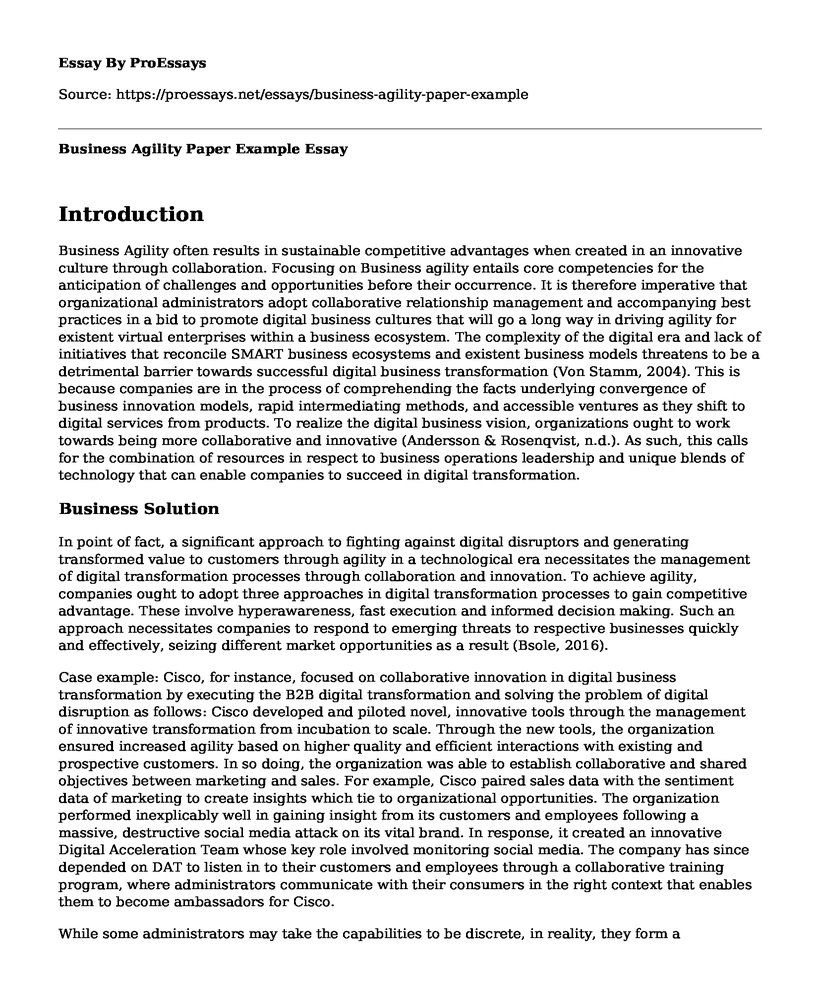Introduction
Business Agility often results in sustainable competitive advantages when created in an innovative culture through collaboration. Focusing on Business agility entails core competencies for the anticipation of challenges and opportunities before their occurrence. It is therefore imperative that organizational administrators adopt collaborative relationship management and accompanying best practices in a bid to promote digital business cultures that will go a long way in driving agility for existent virtual enterprises within a business ecosystem. The complexity of the digital era and lack of initiatives that reconcile SMART business ecosystems and existent business models threatens to be a detrimental barrier towards successful digital business transformation (Von Stamm, 2004). This is because companies are in the process of comprehending the facts underlying convergence of business innovation models, rapid intermediating methods, and accessible ventures as they shift to digital services from products. To realize the digital business vision, organizations ought to work towards being more collaborative and innovative (Andersson & Rosenqvist, n.d.). As such, this calls for the combination of resources in respect to business operations leadership and unique blends of technology that can enable companies to succeed in digital transformation.
Business Solution
In point of fact, a significant approach to fighting against digital disruptors and generating transformed value to customers through agility in a technological era necessitates the management of digital transformation processes through collaboration and innovation. To achieve agility, companies ought to adopt three approaches in digital transformation processes to gain competitive advantage. These involve hyperawareness, fast execution and informed decision making. Such an approach necessitates companies to respond to emerging threats to respective businesses quickly and effectively, seizing different market opportunities as a result (Bsole, 2016).
Case example: Cisco, for instance, focused on collaborative innovation in digital business transformation by executing the B2B digital transformation and solving the problem of digital disruption as follows: Cisco developed and piloted novel, innovative tools through the management of innovative transformation from incubation to scale. Through the new tools, the organization ensured increased agility based on higher quality and efficient interactions with existing and prospective customers. In so doing, the organization was able to establish collaborative and shared objectives between marketing and sales. For example, Cisco paired sales data with the sentiment data of marketing to create insights which tie to organizational opportunities. The organization performed inexplicably well in gaining insight from its customers and employees following a massive, destructive social media attack on its vital brand. In response, it created an innovative Digital Acceleration Team whose key role involved monitoring social media. The company has since depended on DAT to listen in to their customers and employees through a collaborative training program, where administrators communicate with their consumers in the right context that enables them to become ambassadors for Cisco.
While some administrators may take the capabilities to be discrete, in reality, they form a collaborative interacting foundation that captures changes which highlight inevitable challenges and opportunities. Besides, hyperawareness enables companies to collect insight from both internal stakeholders such as employees and external sources like competitors, customers and partners.
Lessons Learnt/Business Case
The learning points that the case provides can be used by other companies based on many economic justifications. To promote business agility in the process of digital transformation, organizations ought to link business outcomes to innovation, de-fragmenting innovative transformation pockets throughout the business. In so doing, the goals and objectives therein should include meeting customers where they are to promote collaboration, reaching more emerging markets and providing sales teams with more time for actual selling practices through collaborative innovation. Thus, the ability to adapt and learn is crucial for the facilitation of collaborative innovation in a company's digital transformation (Wade, 2016). Digitally mature companies, therefore ought to commit themselves to transformative strategies that are supported by digitally collaborative cultures.
Reflections on the impact of learning goals
Through collaborative innovation, it is rather obvious that it results in business agility and ultimately competitive advantage for an organization. The company, as highlighted in Figure 2, by embracing informed decision-making, hyper-awareness for collaborative workforce transformation and fast execution of plans effectively and quickly, can promote behavioural awareness, situational awareness, and dynamic processes, augmented and inclusive decision-making (Burkett and Meehan, 2017).
References
Wade, M. (2016). Digital Business Agility and Workforce Transformation. Retrieved 20 September 2018, from https://www.imd.org/research/publications/upload/60-Digital-Business-Agility.pdf
Burkett, M. & Meehan, P. (2017). Make Digital Business Transformation a Practical Reality: A Gartner Trend Insight Report. Gartner, Inc.
Andersson, P., & Rosenqvist, C. Strategic Challenges of Digital Innovation and Transformation. Per Andersson, Staffan Movin, Magnus Mahring, Robin Teigland, and Karl Wennberg (eds.), 17.
Basole, R. C. (2016). Accelerating digital transformation: Visual insights from the API ecosystem. IT Professional, 18(6), 20-25.
Von Stamm, B. (2004). Collaboration with other firms and customers: innovation's secret weapon. Strategy & Leadership, 32(3), 16-20.
Cite this page
Business Agility Paper Example. (2022, Aug 01). Retrieved from https://proessays.net/essays/business-agility-paper-example
If you are the original author of this essay and no longer wish to have it published on the ProEssays website, please click below to request its removal:
- Situational Approach to Leadership and Management Essay
- Marketing Debate on Product Development Paper Example
- Essay Example on Leadership Challenges for Response Leader: Preparing for Next Pandemic
- Essay Sample on Safety Risk Management: Identify, Evaluate, Analyze & Mitigate Risk
- Essay Sample on Successful Leadership Techniques for Business Management
- Leadership Theories: Trait Theory, Behavioral Model, & More - Free Paper
- Paper on Agile at Scale: Revolutionizing Leadership and Supply Chain Management for Business Excellence







